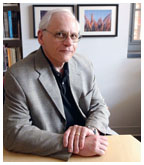
|
October 10, 2007: A moment with...
Robert Wuthnow (Frank Wojciechohwski) |
Robert Wuthnow
How might churches and synagogues in the United States change in coming years? Robert Wuthnow explores this question in a new book, After the Baby Boomers: How Twenty- and Thirty-Somethings Are Shaping the Future of American Religion (Princeton University Press). Wuthnow, the Gerhard R. Andlinger ’52 Professor of Social Sciences and director of the Center for the Study of Religion, discussed his findings — which deal with Catholics, Protestants, and Jews — with PAW’s Mark F. Bernstein ’83.
How are 20- and 30-somethings shaping religion in this country?
I call them “tinkerers” because they try to put together ideas and beliefs and practices from a lot of different sources — religious organizations, certainly, but they also piece together ideas from the Internet, their friends, and their personal experiences. They are very interested in the traditional spiritual questions — “What is the meaning of life and where are we headed?” — but they are different from previous generations in that they have a lot more opportunities to explore ideas from many different sources.
Is that good or bad?
It’s simply the way things are. In my book I tried to explore the implications for religious organizations. What kinds of congregations are appealing to younger adults? The prevailing wisdom is that the mega-churches and mega-synagogues are attracting younger people. They certainly are one of the avenues of the future because they offer so many opportunities and programs. But as it turns out, a lot of the very smallest congregations in the United States have a disproportionate number of young adults, too. One of the reasons is that many of those smaller congregations are composed of immigrants, and there are a lot of immigrants in their 20s and 30s. That ethnic diversity is something that all religious organizations are going to have to come to terms with.
Do people tend to return to organized religion when they get married and start a family?
There is a lot of evidence that this is what happens, but people are marrying five to seven years later than their parents did, and they’re having children later. That has major implications. If that demographic change had not happened, there would be about 6.3 million more young adults attending religious services than there are currently.
Can religious organizations do anything to keep young people involved?
They should be focusing more attention on people in their 20s and 30s. Churches focus a lot of attention on teenagers, assuming that if they keep the teenagers interested, they are the wave of the future. But they aren’t the wave of the future; they’re still very much their parents’ children. All the major life decisions that are going to affect what they do and whether they go to church happen much later, so it’s an ironic situation where the churches try as much as they can to hold everybody’s hand until they are 18 or 21 and then they kiss them goodbye and say, “Well, we’ll see you again when we see you.” That may not be until those kids are 45.
Is it true that evangelical denominations are growing?
It turns out that [evangelical groups] are holding their own, but they are not really growing. They experienced a lot of growth back in the 1970s, with the baby-boomer generation, largely because their congregants were having larger families and having them sooner. So they were replacing themselves faster. But the larger dynamic in the culture of people marrying and having children later has pretty much caught up with those denominations, too.
Many people say, “I don’t go to church, but I am very spiritual.” Is that sentiment on the increase?
I estimate that about a quarter of young adults fit that description. ... Another quarter of young adults say they don’t care about either spirituality or religion.
What attracts people in their 20s and 30s to a church or synagogue?
You have to talk about the two halves of the young adult population.
For the married half, it’s a matter of settling down, becoming part
of the community, anticipating having children, looking for a church program
that their kids can grow up in and serve in. For the other half, the young
single population, there’s not much that religious organizations
are doing now that is effective. Some singles are looking at congregations
as a place to find a mate. But that’s not going to work, because
pretty much everybody who is there is already married. If they do find
a reason to be in a congregation, it’s often a service opportunity,
where they are drawn into serving the community or teaching or doing short-term
mission work. ![]()

